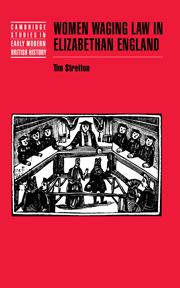Book contents
- Frontmatter
- Contents
- Lists of maps and figures
- List of tables
- Preface
- Notes on the text
- Abbreviations
- 1 Introduction
- 2 Women, legal rights and law courts
- 3 Female litigants and the culture of litigation
- 4 The Court of Requests
- 5 Unmarried women and widows
- 6 Married women in Requests
- 7 Freebench, custom and equity
- 8 Pleading strategies in Requests
- 9 Women waging law
- Glossary
- Bibliography
- Index
- Cambridge Studies in Early Modern British History
4 - The Court of Requests
Published online by Cambridge University Press: 11 November 2009
- Frontmatter
- Contents
- Lists of maps and figures
- List of tables
- Preface
- Notes on the text
- Abbreviations
- 1 Introduction
- 2 Women, legal rights and law courts
- 3 Female litigants and the culture of litigation
- 4 The Court of Requests
- 5 Unmarried women and widows
- 6 Married women in Requests
- 7 Freebench, custom and equity
- 8 Pleading strategies in Requests
- 9 Women waging law
- Glossary
- Bibliography
- Index
- Cambridge Studies in Early Modern British History
Summary
The Angel Raphael … was both a Physitian in restoring his sight, and a sollicitour, or Maister of requests in preferring his suites, to the throne of Almighty God
(A.G.), The Widdowes Mite (London, 1619)The Court of Requests appears to have admitted a higher proportion of female plaintiffs and defendants during the reign of Elizabeth than any other Westminster court. This chapter examines the workings of the court to discover why it was popular with women. It also considers the court's business and clientele to determine the kinds of women who went to law and the matters they litigated. And it provides necessary background for the more detailed examinations of female litigation that follow.
The Court of Requests has received mixed attention from historians. Legal historians have devoted little time to the court, because of its modest stature, its failure to survive beyond the first half of the seventeenth century, and the belief that it operated in the shadow of Chancery and provided no innovation in the fields of equity or law. Social and economic historians have dipped into its archive to investigate specific causes, but as L.M. Hill recently observed, the court and its Masters have ‘been in a historiographic backwater since the sixteenth century’, despite the thousands of case files in its archives that document the legal battles of a broad cross-section of the population.
- Type
- Chapter
- Information
- Women Waging Law in Elizabethan England , pp. 70 - 100Publisher: Cambridge University PressPrint publication year: 1998

